1997 CHEVROLET CORVETTE window
[x] Cancel search: windowPage 5 of 356
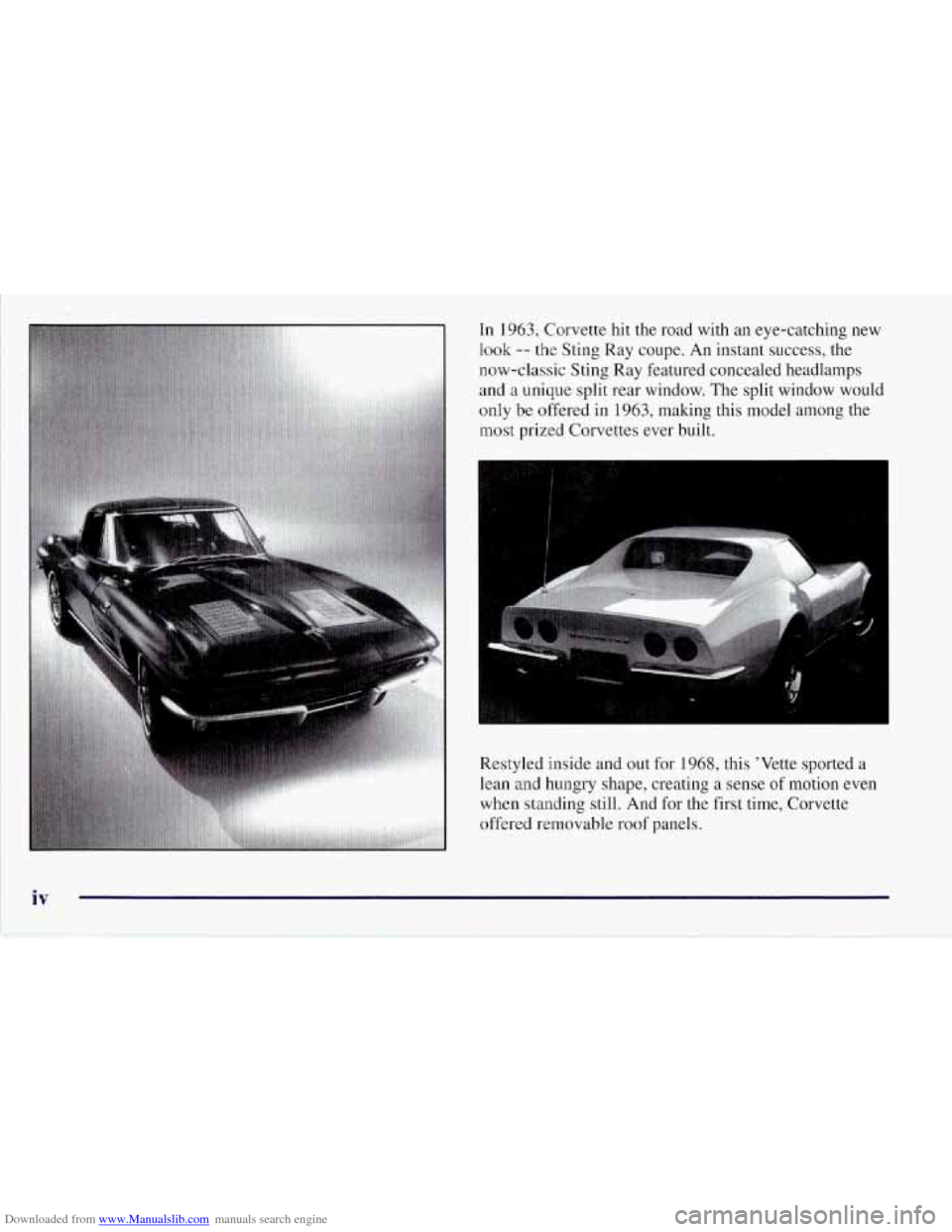
Downloaded from www.Manualslib.com manuals search engine In 1963, Corvette hit the road with an eye-catching new
look -- the Sting Ray coupe. An instant success, the
now-classic Sting Ray featured concealed headlamps
and
a unique split rear window. The split window would
only be offered in
1963, making this model among the
most prized Corvettes ever built.
Restyled inside and out for
1968, this 'Vette sported a
lean and hungry shape, creating a sense of motion even
when standing still. And for the first time, Corvette
offered removable roof panels.
iv
Page 13 of 356
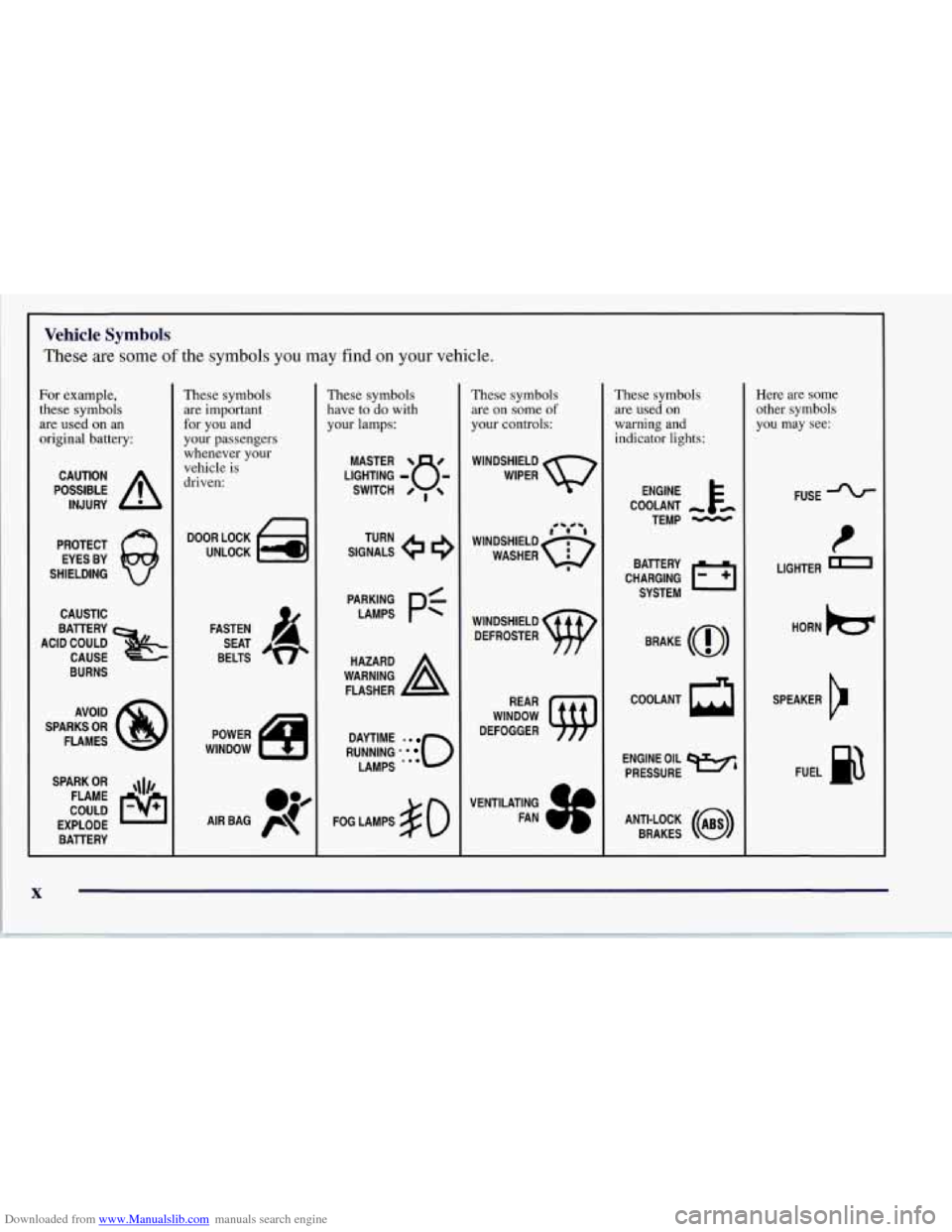
Downloaded from www.Manualslib.com manuals search engine Vehicle Symbols
These are some of the symbols you may find on your vehicle.
For example,
these symbols
are used on an
original battery:
POSSIBLE A
CAUTION
INJURY
PROTECT EYES BY
SHIELDING
CAUSTIC
ACID COULD BATTERY
CAUSE
BURNS
AVOID
SPARKS
OR
FLAMES
SPARK
OR ,\I/,
COULD FLAME
EXPLODE BATTERY
L
These symbols are important
for you and
your passengers
whenever your
vehicle is
driven:
n
UNLOCK w
FASTEN
SEAT
BELTS
These symbols
have to do with
your lamps:
SIGNALS e
TURN
RUNNING
* . 0
DAYTIME -0
LAMPS ***
FOG LAMPS $0
These symbols are on some
of
your controls:
WINDSHIELD
WIPER
WINDSHIELD DEFROSTER
WINDOW
DEFOGGER
VENTILATING FAN
These symbols
are used on
warning and
indicator lights:
COOLANT
TEMP
-
CHARGING I-1
BATTERY
SYSTEM
BRAKE
(0)
ENGINE OIL w,
PRESSURE
ANTI-LOCK
(a)
BRAKES
Here are some
other symbols you may see:
FUSE -%-
LIGHTER m
HORN )a(
SPEAKER
b
FUEL B
Page 36 of 356
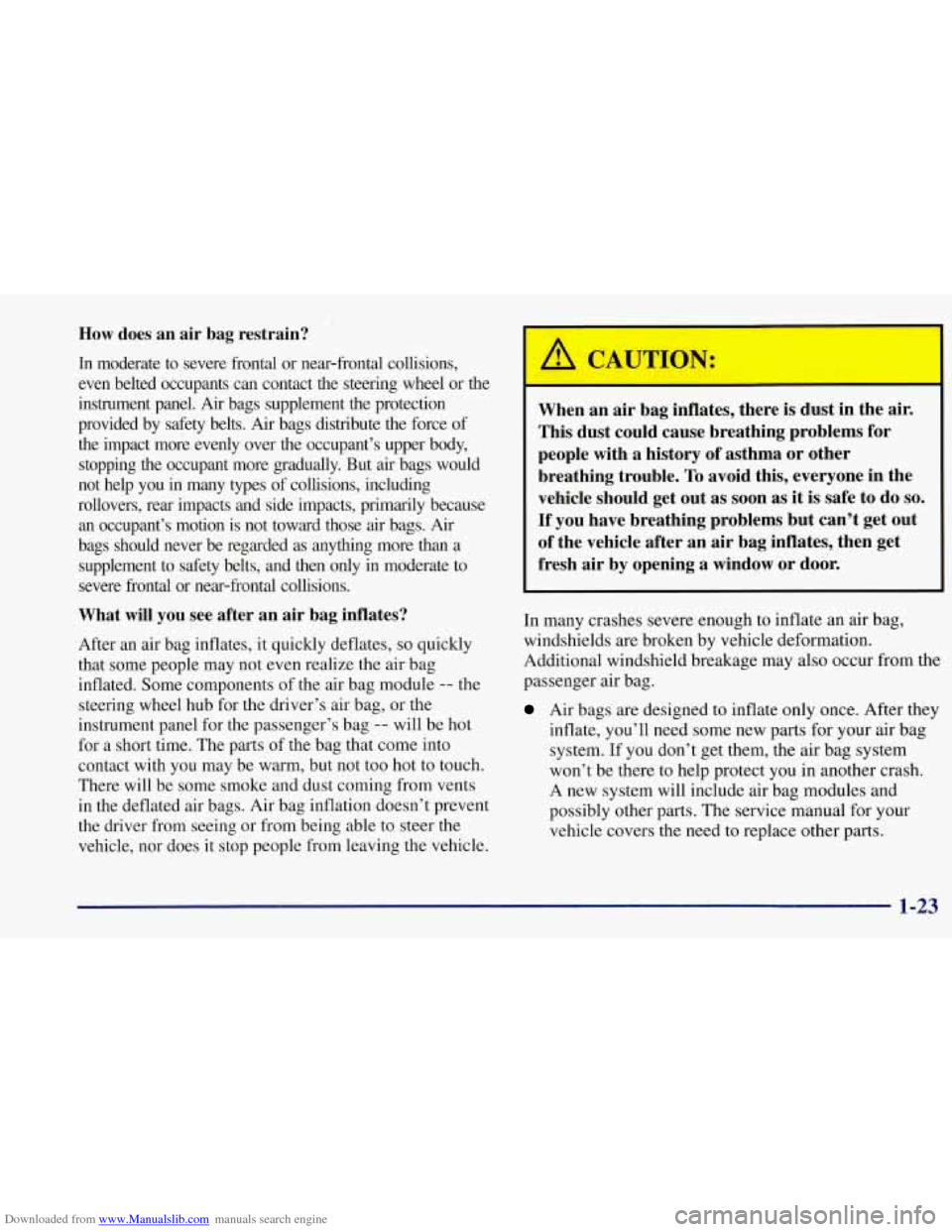
Downloaded from www.Manualslib.com manuals search engine How does an air bag restrain?
In moderate to severe frontal or near-frontal collisions,
even belted occupants can contact the steering wheel or the
instrument panel.
Air bags supplement the protection
provided by safety belts.
Air bags distribute the force of
the impact more evenly over the occupant’s upper body, stopping the occupant more gradually. But air bags would
not help you in many types of collisions, including
rollovers, rear impacts and side impacts, primarily because an occupant’s motion is not toward those air bags. Air
bags should never be regarded as anything more
than a
supplement to safety belts, and then only in moderate to
severe frontal or near-frontal collisions.
What will you see after an air bag inflates?
After an air bag inflates, it quickly deflates, so quickly
that some people may not even realize the air bag
inflated. Some components of the air bag module
-- the
steering wheel hub for the driver’s air bag, or the
instrument panel for the passenger’s bag
-- will be hot
for a short time. The parts of the bag that come into
contact with
you may be warm, but not too hot to touch.
There will be some smoke and dust coming from vents
in the deflated air bags. Air bag inflation doesn’t prevent
the driver from seeing or from being able to steer the
vehicle, nor does it stop people from leaving the vehicle.
When an air bag inflates, there is dust in the air.
This dust could cause breathing problems for
people with a history of asthma or other
breathing trouble.
To avoid this, everyone in the
vehicle should get out as soon as it
is safe to do so.
If you have breathing problems but can’t get out
of the vehicle after an air bag inflates, then get
fresh air by opening a window or door.
In many crashes severe enough to inflate an air bag,
windshields are broken by vehicle deformation.
Additional windshield breakage may also occur from the
passenger air bag.
Air bags are designed to inflate only once. After they
inflate, you’ll need some new parts for your air bag
system.
If you don’t get them, the air bag system
won’t be there to help protect you in another crash.
A new system will include air bag modules and
possibly other parts. The service manual for your
vehicle covers the need
to replace other parts.
1-23
Page 50 of 356
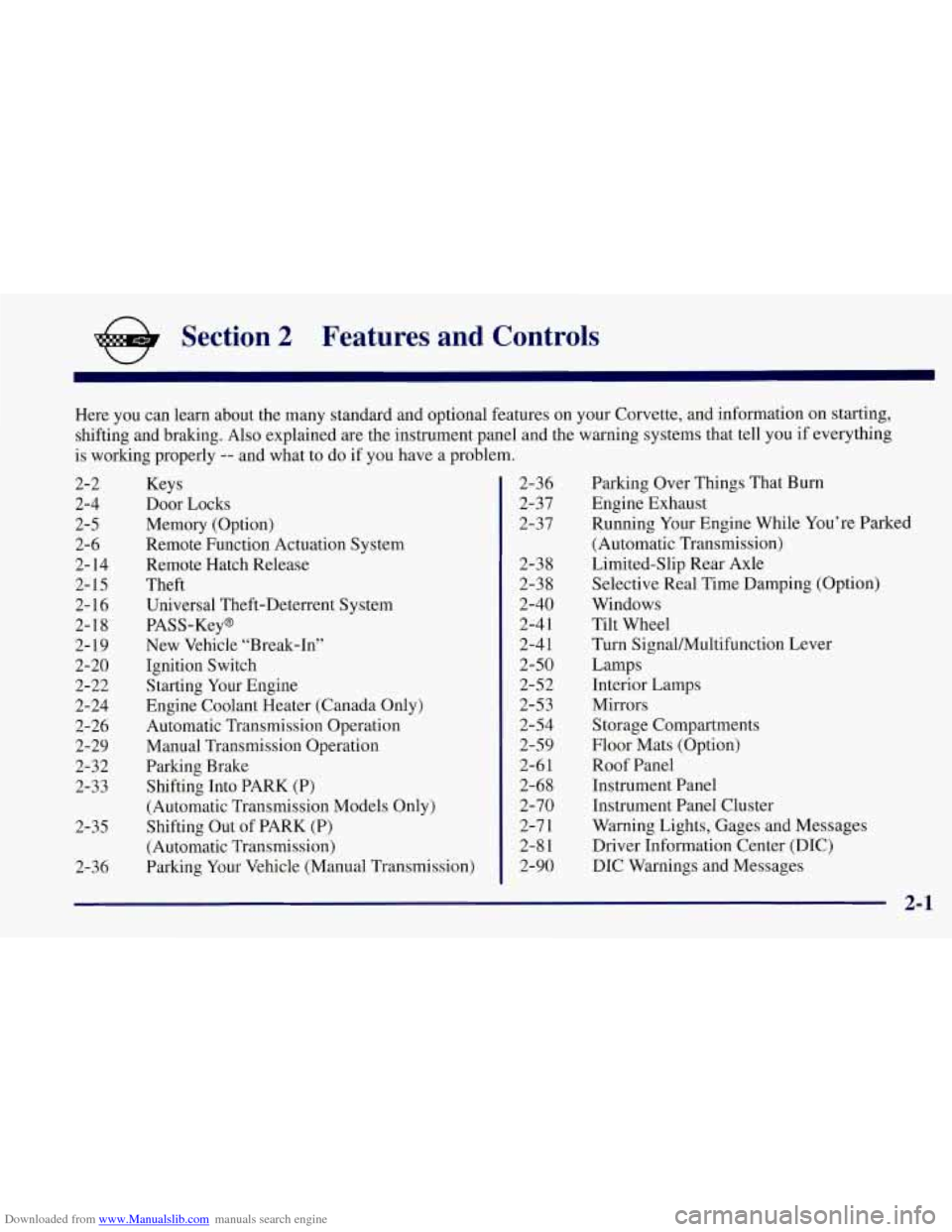
Downloaded from www.Manualslib.com manuals search engine e Section 2 Features and Controls
~~ ~~
Here you can learn about the many standard and optional features on your Corvette, and information on starting,
shifting and braking. Also explained are the instrument panel and the warning systems that tell you if everything
is working properly
-- and what to do if you have a problem.
2-2
2-4
2-5
2-6
2- 14
2-15
2- 16
2-18
2-19
2-20
2-22
2-24
2-26
2-29
2-32
2-33
2-35
2-36 Keys
Door
Locks
Memory (Option)
Remote Function Actuation System
Remote Hatch Release
Theft
Universal Theft-Deterrent System
PASS-Key@
New Vehicle “Break-In”
Ignition Switch Starting Your Engine
Engine Coolant Heater (Canada Only)
Automatic Transmission Operation
Manual Transmission Operation
Parking Brake
Shifting Into PARK (P)
(Automatic Transmission Models Only)
Shifting Out
of PARK (P)
(Automatic Transmission)
Parking Your Vehicle (Manual Transmission) 2-36
2-37
2-37
2-38
2-38
2-40
2-4 1
2-4
1
2-50
2-52
2-53
2-54
2-59
2-6
1
2-68 2-70
2-7
1
2-8 1
2-90 Parking
Over Things That Bum
Engine Exhaust
Running Your Engine While You’re Parked
(Automatic Transmission)
Limited-Slip Rear Axle
Selective Real Time Damping (Option)
Windows
Tilt Wheel Turn Signal/Multifunction Lever
Lamps
Interior Lamps
Mirrors Storage Compartments
Floor Mats (Option)
Roof Panel
Instrument Panel
Instrument Panel Cluster
Warning Lights, Gages and Messages
Driver Information Center (DIC)
DIC Warnings and Messages
2-1
Page 51 of 356
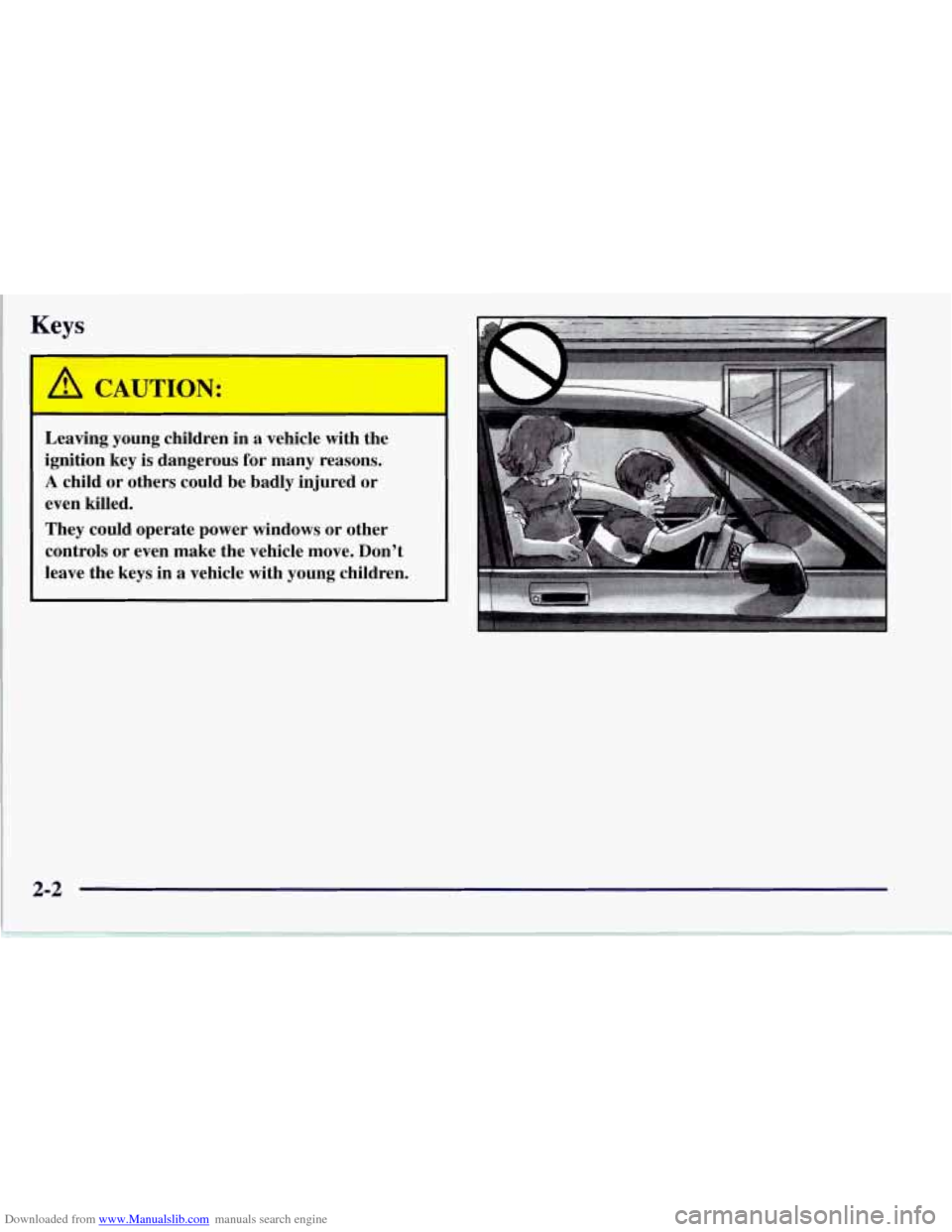
Downloaded from www.Manualslib.com manuals search engine Leaving young children in a vehicle with the
ignition key is dangerous for many reasons.
A child or others could be badly injured or
even killed.
They could operate power windows or other
controls or even make the vehicle move. Don’t
leave the keys in a vehicle with young children.
Page 64 of 356

Downloaded from www.Manualslib.com manuals search engine It ca-- 3e dangerous to drive with the hatch open
because carbon monoxide
(CO) gas can come into
your vehicle. You can’t see or smell
CO. It can
cause unconsciousness and even death.
If you must drive with the hatch open or if
electrical wiring or other cable connections
must pass through the seal between the body
and the hatch:
0 Make sure all windows are shut.
Turn the fan on your heating or cooling
system to its highest speed with the setting
on BI-LEVEL or VENT. That will force
outside air into your vehicle. See “Comfort
Controls” in the Index.
instrument panel, open them all the way.
0 If you have air outlets on or under the
See “Engine Exhaust” in the Index.
NOTICE:
If you put things in the hatch area, be sure they
won’t break the glass when you close it.
Never slam the hatch down. You could break the
glass or damage the defogger grid.
When you close the hatch, make sure you pull
down from the center, not the sides.
If you pull
the hatch down from the side too often, the
weatherstrip can be damaged.
Theft
Vehicle theft is big business, especially in some cities.
Although your Corvette has a number of theft-deterrent
features, we know that nothing
we put on it can make
it impossible to steal. However, there are ways you
can help.
2-15
Page 65 of 356

Downloaded from www.Manualslib.com manuals search engine Key in the Ignition
If you leave your vehicle with the keys inside, it’s an
easy target for joy riders or professional thieves
-- so
don’t do it.
When you park your Corvette and open the driver’s
door, you’ll hear a tone reminding you
to remove your
key from the ignition and take it with you. Always do
this. Your steering wheel will be locked, and
so will
your ignition.
If you have an automatic transmission,
taking your key out also locks your transmission. And
remember to lock the doors.
Parking at Night
Park in a lighted spot, close all windows and lock your
vehicle. Remember to keep your valuables out
of sight.
Put them in a storage area, or take them with you.
Parking Lots
If you park in a lot where someone will be watching
your vehicle, it’s best to lock it up and take your keys.
But what if you have to leave your key?
Do not leave
valuables
in your vehicle, since there would be no place
to secure them.
Universal Theft-Deterrent System
SECURITY
Your Corvette has a
theft-deterrent alarm
system. With this system,
the SECURITY light will
flash as you open the door
(if your ignition is off). This
light reminds you to arm the
theft-deterrent system.
To arm the system, do the following:
1. Press the LOCK button on the key fob transmitter, as
2. Walk out of range with the passive switch on, OR
3. Open the door. (The SECURITY light should flash.)
Lock the door with the power door lock switch. The
SECURITY light will stop flashing and stay on. Close
all the doors. The SECURITY light should
go off.
Now, if a door or the hatch is opened without the key or
the key fob transmitter system, the alarm will go
off.
Your horn will sound for two minutes, then it will go off
to save battery power. And, your vehicle won’t start.
mentioned earlier,
OR
2-16
-
Page 66 of 356
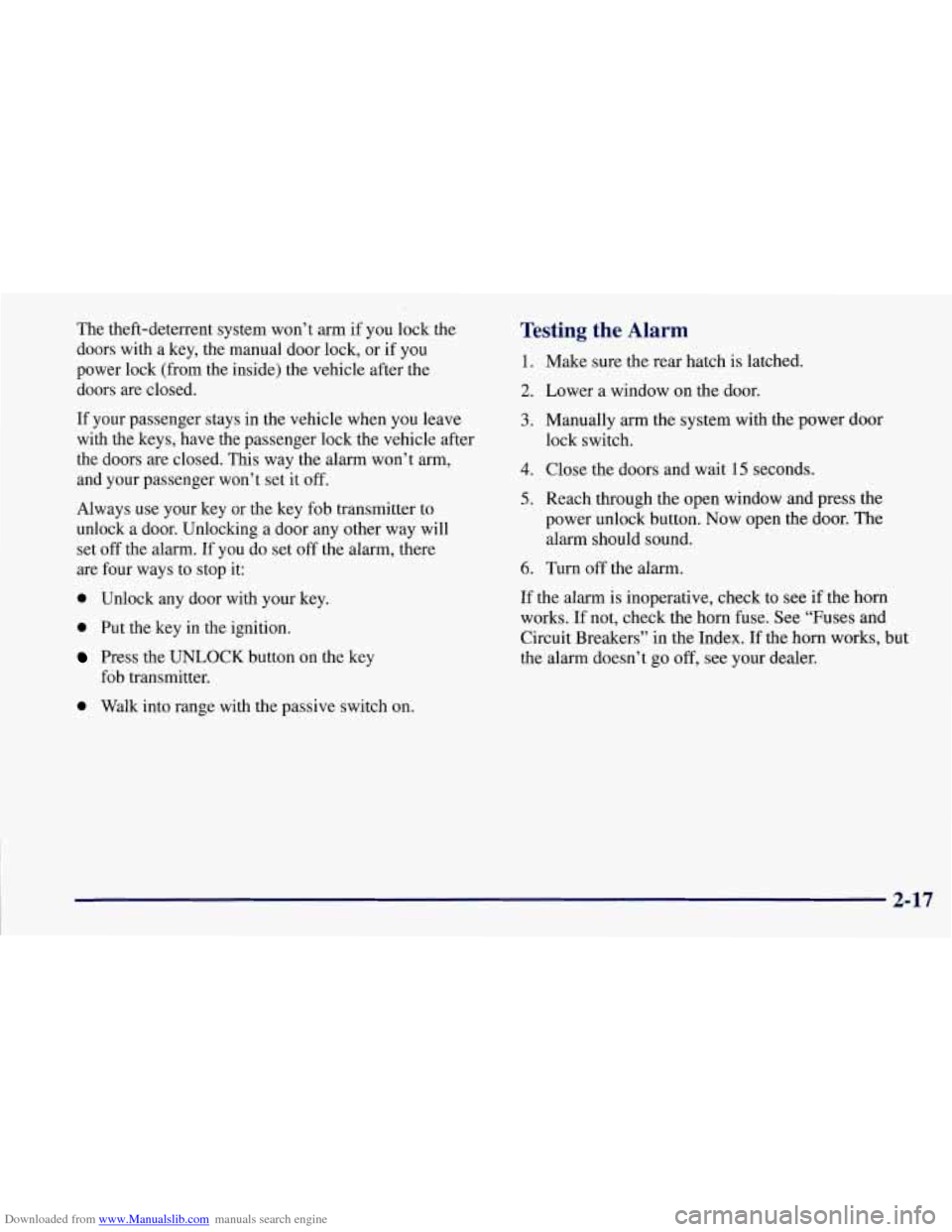
Downloaded from www.Manualslib.com manuals search engine The theft-deterrent system won’t arm if you lock the
doors with a key, the manual door lock, or if you
power lock (from the inside) the vehicle after the
doors are closed.
If your passenger stays in the vehicle when you leave
with the keys, have the passenger lock the vehicle after
the doors are closed. This way the alarm won’t arm,
and your passenger won’t set it
off.
Always use your key or the key fob transmitter to
unlock a door. Unlocking a door any other way will
set off the alarm. If you do set
off the alarm, there
are four ways to stop it:
0 Unlock any door with your key.
0 Put the key in the ignition.
Press the UNLOCK button on the key
fob transmitter.
0 Walk into range with the passive switch on.
Testing the Alarm
1.
2.
3.
4.
5.
6.
Make sure the rear hatch is latched.
Lower a window on the door.
Manually arm the system with the power door
lock switch.
Close the doors and wait
15 seconds.
Reach through the open window and press the
power unlock button. Now open the door. The
alarm should sound.
Turn off the alarm.
If the alarm is inoperative, check to see if the horn
works. If not, check the horn fuse. See “Fuses and
Circuit Breakers” in the Index. If the horn works, but
the alarm doesn’t
go off, see your dealer.
2-17